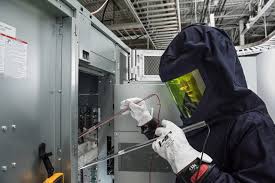 Square D NFPA 70E Compliance framework enhances the safety and reliability of your power system.
Square D NFPA 70E Compliance framework enhances the safety and reliability of your power system.
The Occupational Safety and Health Administration (OSHA) mandates that work on electrical equipment must be performed in a manner that does not expose the worker to undue risk of injury. OSHA enforces electrical workplace safety standards outlined in the National Fire Protection Association’s NFPA 70E: Standard for Electrical Safety in the Workplace®. NFPA 70E specifies that an arc flash hazard analysis must be updated whenever there is a major modification or renovation to the electrical system or, at the maximum, every five years.
Schneider Electric Engineering Services advocates compliance to NFPA 70E not only for worker safety, but also equipment productivity. An arc flash accident can render equipment unusable and place the facility in a costly downtime mode.
Square D NFPA 70E Compliance through basic OSHA and NFPA 70E compliance is established with a five-step process; a sixth step assists the facility owner with fine tuning the electrical power system, both for safety and operability.
Step 1 – Develop and Audit an Electrical Safe Work Practices (ESWP) Policy
Step 2 – Conduct an Electrical System Study to Determine the Present Degree of Arc Flash Hazards and Label the Equipment
Step 3 – Ensure Adequate Supplies of PPE and Proper Tools
Step 4 – Conduct Regular Safety Training and Employee Assessments
Step 5 – Maintain All Electrical Distribution System Components
Step 6 – Follow Strategies to Reduce and Control Arc Flash Hazards
Step 1 – Develop and Audit an Electrical Safe Work Practices (ESWP) Policy
The ESWP policy includes topics such as lock out/ tag out procedures, method of qualifying workers, selection and application of personal protective equipment (PPE), methods of establishing a safe work area, arc flash and shock protection calculations, and equipment labeling. It also defines the requirements for safe work practices and requires audits on at least a three-year cycle. If audits determine that the principles and procedures of the electrical safety program are not being followed by the workers, appropriate revisions to the training program or to the procedures shall be made.
Step 2 – Conduct an Electrical System Study to Determine the Present Degree of Arc Flash Hazards and Label the Equipment
An arc flash hazard analysis must be updated when a major renovation or modification takes place. At a minimum, it should be reviewed every five years because changes in the electrical distribution system could affect the calculated incident energy levels. Additionally, equipment that is likely to be examined, adjusted, serviced, or maintained while energized must be field-marked with a label containing specific information pertaining to shock and arc flash protection. The calculation method and data to support the information for the label shall be documented. The methodology for conducting an arc flash analysis is outlined in IEEE 1584™ Guide for Performing Arc-Flash Hazard Calculations. Our power system engineering team is staffed with professional engineers and project managers to assure an effective arc flash study and labeling are performed with minimal intrusion to your processes.
Step 3 – Ensure Adequate Supplies of PPE and Proper Tools
Employees working in areas where there are potential electrical hazards must be provided PPE that is appropriate for the specific parts of the body to be protected. Additional requirements include properly-rated equipment to test voltages and insulated tools for workers who perform testing and troubleshooting on energized equipment.
Step 4 – Conduct Regular Safety Training and Employee Assessments
Electrical workers are not considered to be qualified by OSHA until they have received safety training specific to the hazards of arc flash, arc blast, shock, and electrocution. Further, the employer must verify, through regular supervision or inspection (conducted at least on annual basis) that each worker complies with the safety-related work practices required by NFPA 70E. Our training department is staffed with OSHA Authorized Outreach Trainers to help ensure your employees are formally trained and aware of electrical hazards per the regulatory requirements.
Step 5 – Maintain All Electrical Distribution System Components
Unless adequate maintenance is performed, overcurrent protective devices may not function and the electrical system study and the arc flash analysis may not be a correct representation of the potential performance of the power system. Our qualified field services personnel perform onsite preventive and predictive maintenance services for any manufacturer’s electrical equipment. Upon completion, a detailed report is provided that identifies potential issues along with corrective recommendations.
Step 6 – Follow Strategies to Reduce and Control Arc Flash Hazards
This step is crucial in optimizing the safety and performance of the power system. The goal of arc flash mitigation is to reduce the arc flash energy, and thus the PPE, to a level that permits normal tasks to be performed on equipment. Arc flash mitigation has been a rapidly developing area of research and development for Schneider Electric. We can help you choose the most cost-efficient alternative to reduce arc flash energy and improve worker safety.
For more information about Square D NFPA 70E Compliance,
call 86 21 5859 8677 or email sales@alphaenertech.com.
